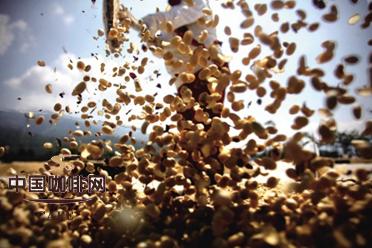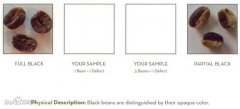The production process of coffee beans A coffee tree can harvest 3 Mel 5 kg of fruit.
A coffee tree can harvest 3-5 kg of fruit, and raw coffee beans account for 1/5 of the fruit mass. Going from fruit to green coffee beans is indeed a time-consuming and laborious task.

Arabian, Robusta, Libyan subspecies
Arabica coffee accounts for about two-thirds of the world's coffee production. Plants are not suitable for high temperature, low temperature, rainy and rainy environments. Coffee beans are oval and flat, with high quality and rich aroma.
Robusta coffee has a strong bitter taste, no sour taste, and no good aroma, which is better mixed than used alone. It is often used to make frozen coffee, instant coffee and canned coffee. Suitable for planting in low-lying areas. The plant has strong disease resistance and fast growth characteristics.
Liberia grows coffee, which is of low quality and yield and is exported only to Europe.
Flat beans and round beans
The ripe red coffee fruit, shown here, has a multi-layered structure. The pale green kernel with a bluish center is the coffee bean.
The core of the coffee fruit is generally oval. When the two stones are paired together, they form a flat bean; sometimes the stone grows singly, forming a round bean. The difference between the two types of beans is mainly in taste.
From harvest to delivery
After harvest, the skin and flesh must be removed. Coffee beans are made by removing the endocarp and silver peel. There are two methods: drying (natural drying, non-washing) and washing.
Drying type, the operation is relatively simple, the harvested fruit spread on the dry site, in the sun for a week or two, turning when you can hear the sound of cluck cluck said dried. Then use a hulling machine to remove the flesh, endocarp and silver skin of the dried fruit.
This method gives coffee beans a mild acidity and a mild bitterness. Brazil, Ethiopia, Yemen and other places to use this method. Disadvantages: easily affected by weather, defective beans and foreign bodies mixed with more opportunities. Therefore, careful selection is required before shipment.
The method comprises the following steps of: pouring harvested fruits into a water tank, removing floating matters, moving the fruits in water into a pulp removing machine, stripping the skin and pulp, then putting the fruits back into the water tank, removing floating matters, pouring the "fruit core" in water into a fermentation tank, soaking for half a day or one day, removing colloid on the surface of fermented beans, washing, drying or mechanically drying, removing the endocarp on a hulling machine, and obtaining commercial green coffee beans.
The advantages of washing: coffee beans luster is good, mixed with less foreign matter, sour slightly better. This approach has been used in Colombia, Mexico and Guatemala. Coffee beans produced with water washing account for almost 70% of the total coffee bean production.
Sometimes bad fermentation time will produce fermentation odor and special sour taste; well processed, coffee beans can form a personalized aroma.
At this time, coffee beans can be packed into sacks and sent to various places, or packed into special containers across the ocean.
Important Notice :
前街咖啡 FrontStreet Coffee has moved to new addredd:
FrontStreet Coffee Address: 315,Donghua East Road,GuangZhou
Tel:020 38364473
- Prev

On the characteristics and uses of Robusta Coffee beans
"Robusta" coffee, commonly known as "sturdy beans", can be grown at low elevations (200 to 800 meters above sea level), has strong resistance to diseases and insect pests, is not vulnerable to agricultural disasters, has a high annual output per unit area, and is harvested in large quantities by machine. in general, the cost of production is much lower than that of Arabica coffee. "Robusta" coffee usually has an ordinary, rigid and pungent flavor, and because
- Next

SCAA Fine Coffee grading defective Bean Standard
All black beans / part of black beans appearance features: black opaque raw bean cup sensory features: diversity: fermentation taste, sharp choking taste, turbidity, mildew taste, sharp sour taste, chemical irritation and other single or multiple odors mixture. Cause: excessive fermentation, leading to microbial invasion and infection. Appearance characteristics of whole sour beans / partial sour beans: raw beans have a yellow, yellowish brown or reddish brown appearance, usually
Related
- Guji coffee producing area of Guji, Ethiopia: Humbela, Shakiso, Wulaga
- What is the most expensive variety of Qiloso in BOP multi-variety group?
- How to store the coffee beans bought home?
- Why are Yemeni coffee beans so rare now?
- Ethiopian Sidamo all Red Fruit Sun Sun Santa Vini Coffee beans
- SOE is mostly sour? What does it mean? Is it a single bean? what's the difference between it and Italian blending?
- Is Italian coffee beans suitable for making hand-brewed coffee?
- How to choose coffee beans when making cold coffee? What kind of coffee beans are suitable for making cold coffee?
- Just entered the pit to make coffee, what kind of coffee beans should be chosen?
- Can only Japan buy real Blue Mountain Coffee? What are authentic Jamaican Blue Mountain coffee beans?

